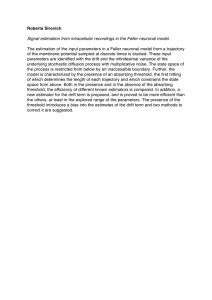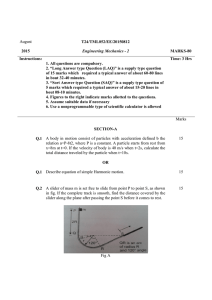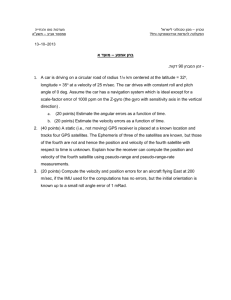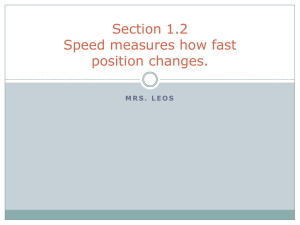V. PHYSICAL ACOUSTICS* Academic and Research Staff
advertisement
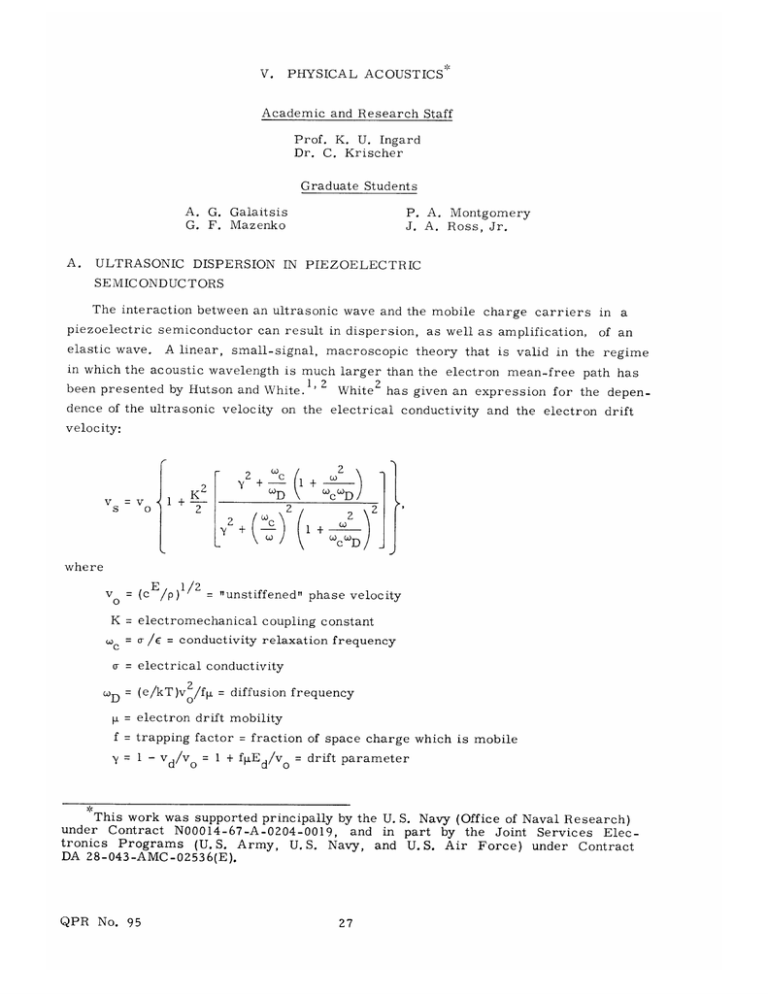
V.
PHYSICAL ACOUSTICS*
Academic and Research Staff
Prof. K. U. Ingard
Dr. C. Krischer
Graduate Students
A. G.
G. F.
A.
ULTRASONIC
Galaitsis
Mazenko
P. A. Montgomery
J. A. Ross, Jr.
DISPERSION IN PIEZOELECTRIC
SEMICONDUCTORS
The interaction between an ultrasonic wave and the mobile charge carriers in a
piezoelectric semiconductor can result in dispersion, as well as amplification, of an
elastic wave. A linear, small-signal, macroscopic theory that is valid in the regime
in which the acoustic wavelength is much larger than the electron mean-free path has
been presented by Hutson and White.l' 2 White 2 has given an expression for the dependence of the ultrasonic velocity on the electrical conductivity and the electron drift
velocity:
2 +
s
0
K2
+
2
1+
D
2
cCwD
2
5
j
+c
D
where
= (cE/p
v
2 = "unstiffened" phase velocity
K = electromechanical coupling constant
c
= - /E = conductivity relaxation frequency
a- = electrical conductivity
WD = (e/kT)v 2 /fL = diffusion frequency
= electron drift mobility
f = trapping factor = fraction of space charge which is mobile
y =
- Vd/o = 1 + fp Ed/Vo = drift parameter
This work was supported principally by the U. S. Navy (Office of Naval Research)
under Contract N00014-67-A-0204-0019,
and in part by the Joint Services Electronics Programs (U. S. Army, U. S. Navy, and U. S. Air Force) under Contract
DA 28-043-AMC-02536(E).
QPR No. 95
(V.
PHYSICAL ACOUSTICS)
Ed = applied electric drift field
w = elastic wave angular frequency.
The range of possible phase velocities lies between vD = v (1+K
2
1/2
)
=
o(1+K /2)
In the limit of small conductivities and large values of drift parameter, the
and v .
o
charge carriers cannot effectively "cancel out" the longitudinal electrostatic field of
piezoelectric origin that is produced by the ultrasonic wave, and therefore vs approaches
the fully stiffened velocity, vD.
drift parameter,
Conversely,
in the limit of high conductivity and small
there does occur effective electron bunching which cancels out the
piezoelectric field; hence, vs approaches the unstiffened velocity v o.
conductivity, v s has a minimum value when y = 0, that is,
For any given
when the electron drift veloc-
ity equals the sonic velocity.
We are now investigating the dependence of the phase velocity in CdS on the electrical
conductivity and applied drift field.
Our sample dimension is 1 cm along the direction
of propagation and approximately 0. 5 X 0. 5 cm in cross section.
The transverse-wave
acoustic pulses, propagating in the basal plane with polarization along the c axis, are
generated and detected by two 32-MHz Y-cut quartz transducers bounded to the sample
ends.
The complete delay line is mounted in a holder in thermal contact with a thermo-
electric module,
and its temperature is maintained at 20 ± 0. 2 0 C.
The total insertion loss for the delay line (with the ultrasonic attenuation minimized
by keeping the CdS sample in the dark) varies from 20 dB at the fundamental frequency
(32 MHz) to 50 dB at the 13 t h harmonic (410 MHz).
data over a wide range of frequencies.
We shall therefore be able to obtain
The electrical conductivity is adjusted by varying
the light intensity from a tungsten-filament quartz-iodine lamp powered by a regulated
DC supply.
A range of more than four orders of magnitude variation in the conductivity
is obtained.
A pulsed, low duty-cycle drift field is used to minimize the errors caused
by heating. (For example, at 20
0
C, a temperature change of ±1°C results in an observed
apparent velocity change of ±0. 01%7).
The variations in phase velocity are measured by
using a standard phase-interference technique.
The input radiofrequency is adjusted so
that the delayed output signal interferes destructively with the input signal.
The rela-
tive velocity changes are thus measured as relative changes in the null frequency.
Figure V-i shows the results of measurements carried out at 94 MHz.
Data could
not be obtained for the medium conductivities at drift fields below 500 V/cm because the
ultrasonic attenuation in this region is too large:
the signal is masked by the presence
of a piezoelectrically inactive acoustic wave (polarized in the basal plane), whose phase
velocity is very nearly equal to that of the active wave.
The data for large conductivities
at the higher drift fields were limited by the build-up of ultrasonic flux.
The total range
of velocity variation corresponds to a value of K 2 = 0.035, which compares very favorably
with the value of 0.036 reported by Hutson and White.1 Our results differ significantly
QPR No. 95
(V.
0
PHYSICAL ACOUSTICS)
20
0
0e00
0
40
*0*
800
0
.5
01
0
1600
0•
2.0
5 0
0*
00
*00
f=94 MHz
1.0
S2.o
1500
1000
500
2000
DRIFT FIELD(Vicm)
Fig. V-1.
Variation of phase velocity with electrical conductivity and
applied drift field for a 94-MHz piezoelectrically active
transverse wave in CdS (a=
10
- (Q-ra)
).
from the predictions of Hutson and White's theory in one respect:
corresponding to minimum velocity decreases
ductivity.
monotonically
the drift field
with increasing
con-
We shall attempt to determine whether these results are consistent with
the assumption of a complex trapping factor which occurs
time of the trapped electrons is
wave period.
when the equilibration
of the same order of magnitude
(Ishiguro and co-workers
3
as the elastic
have shown that the observed asymmetry
in the ultrasonic gain-loss vs drift field curves
results from a complex trapping
factor.)
C. Krischer
QPR No. 95
(V.
PHYSICAL ACOUSTICS)
References
33, 40 (1962).
A. R. Hutson and D. L. White, J. Appl. Phys.
D. L. White, J. Appl. Phys. 33, 2547 (1962).
IEEE Trans.,
T. Ishiguro, I. Uchida, T. Suzuki, and Y. Sasaki,
1965.
1.
2.
3.
B.
FIELD
NONLINEAR INTERACTION BETWEEN A SOUND
AND A LIQUID SURFACE
1.
Static Pressure Distribution in Sound Field
Vol. SU-12, p. 9,
time average of the pressure in
It follows from the Navier-Stokes equation that the
where p is the density,
a one-dimensional sound field is given by (p) = -(pu ) + const,
velocity field obtained from
and u is the velocity. Thus, if ul represents the first-order
of the pressure, correct to second
the linearized equations of motion, the time average
unperturbed density.
order, is (pZ = -Po(u ) + const, where po is the
tube, we find that the spatial disApplying this result to a standing wave in a closed
=
tribution of the time average or static pressure in the sound field is of the form (pZ)
maximum
the wavelength, pl0 the
p 0 /4Poc 2 ) cos (Zkx)= p2 0 cos Zkx, where (2wr/k) is
wave, and c the speed of sound.
first-order sound pressure amplitude in the standing
a simple manner by letting this
This pressure distribution can be demonstrated in
parallel with the x direction.
sound-pressure field act on a horizontal liquid surface
the surface which varies with x as
This interaction results in a vertical displacement of
levels of the sound pressure the
cos (Zkx), as shown in Fig. V-2. At sufficiently high
Fig. V-2.
QPR No. 95
distribution in a
Demonstration of the time average (static) pressure
effect.
fountain
acoustic
the
and
standing sound wave
(V.
PHYSICAL ACOUSTICS)
surface is ruptured and "fountains" occur at the pressure nodes.
This also can be seen
in Fig. V-2.
This phenomenon has been known for a long time,
the fountain effect has been given.
but no satisfactory explanation of
Questions that relate to the conditions for the onset
of the fountain such as threshold sound pressure have not been answered.
In order to try to better understand this phenomenon, we have studied sound-liquid
surface interaction, using cavities of different shapes and with, liquids of several different viscosities and surface tensions.
The most extensive measurements were made in cylindrical cavities 38 in.
long with inner diameters of 1 3/4 in.
and 1 3/8 in. , respectively.
and 15 in.
The cavities were
driven at one end by a loudspeaker, and at the other end a microphone was mounted
flush with the rigid end wall.
The driving frequency was kept below the cutoff frequen-
cies of higher duct modes so that only the plane-wave component was generated.
The
static pressure distribution in the sound field was measured by means of a sloping tube
manometer,
and the surface deformation was determined by a cathetometer.
pressure level of 164 dB could be produced at various
3.0
tube
resonance
A soundfrequencies
-
400
O
0.050" ORIFICE
o
0.074" ORIFICE
A
0.125" ORIFICE
800
1200
FREOUENCY (Hz)
Fig. V-3.
QPR No. 95
Pressure difference between antinode and node as measured with
the manometer at a sound level of 164 dB. Results for three different probe orifice diameters are shown.
(V.
PHYSICAL ACOUSTICS)
between 200 Hz and 1200 Hz.
Measurements of the static pressure distribution by means of the manometer turned
out not to be particularly accurate.
It was found that the results were influenced by the
size of the probe orifice of the manometer and also by the frequency.
This is probably
due to local distortion or diffraction of the sound field about the orifice.
Accordingly,
the time average pressure at the probe can be considerably different from the pressure
The frequency dependence of the manometer output for three
in the plane-wave field.
different probe orifice diameters is shown in Fig. V-3.
This second-order time average
in the diffracted sound field will be explored in more detail in a separate report.
With the static second-order pressure distribution given by p 2 0 cos (2kx), the height
of the liquid surface should vary as
l
1+)} cos (2kx),
Yo - {P 2 0 /Pg(
y
where
(2k) 2
=
-
PLg
and
p
P20
and
pZ
P1 0
4pc 2
'
with pL = density of liquid; g = acceleration of gravity; a- = surface tension;
and p 1 0
sound pressure amplitude. The difference in height of the liquid surface at the antinode
and at the node is then 2p
20
/PLg(1+
).
Measurement of this difference was made in the
38-in. cavity (water depth -1. 5 cm) at a maximum sound-pressure level of 163. 3 dB and
at frequencies between 200 Hz and 1200 Hz.
For water at 20
0
C the measured height dif-
ference was found to be independent of frequency and equal to 0. 55 cm, with a
deviation of 0. 03 cm.
2.
standard
This is in excellent agreement with the calculated value 0. 54 cm.
Fountain Effect
If the sound level exceeds a certain threshold value, the liquid erupts suddenly at the
antinodes,
and this eruption, or fountain effect, is maintained by the sound field.
the threshold the liquid surface is deformed as described above.
tortion of the surface, however,
Below
There is no other dis-
which would indicate that the surface might erupt. The
threshold sound level does not depend on the cross-sectional tube area of the region
above the liquid surface, nor upon the frequency in the region considered,
200 Hz and 2000 Hz.
The threshold level depends,
however,
between
on the surface tension and
the density of the liquid.
When the fountains are formed, the liquid surface is distorted by the static pressure
distribution before the eruption.
The question arises about the role of this initial dis-
tortion in the formation of the fountain.
QPR No. 95
To check this, the liquid surface was replaced
(V.
PHYSICAL ACOUSTICS)
with a flat solid block with the exception of a small region, a groove, near a pressure
antinode.
The liquid in the groove would suddenly begin to spray out of the groove when
the threshold sound level was reached. This continued until the groove was very nearly
empty.
Thus we conclude that the over-all shape of the liquid surface as affected by the
static pressure distribution is not an important factor in the formation of fountains.
It is difficult to determine the threshold of the sound pressure above which fountains
occur.
One reason is that often no fountains are formed immediately, even if the level
exceeds the threshold determined from a previous experiment.
(~1-10 sec), however, a fountain will erupt.
A short time later
Furthermore, the phenomenon exhibits
"hysteresis"; the fountains, once started, can be maintained at a level below the threshold.
3.0
A
oA
A
2.5
A
0
o
0
So
1-PROPANOL
Z
7)
o
O
2.0
A
METHANOL
A
30
50
70
SURFACETENSION (dynes/cm)
Fig. V-4.
Threshold sound level for fountain formation is shown as a
function of surface tension.
Actually, if an initial distortion of the liquid is produced by touching it with a thin
rod and then pulling the surface up to form a ridge, a fountain can be produced and maintained after removal of the rod, at a level approximately 20% below the actual threshold.
The threshold determined in this manner was quite reproducible and could be accurately
determined. In Fig. V-4 this threshold is shown as a function of the surface tension of
two-component systems of propanol-water and methanol-water. The surface tension
was varied by varying the concentration of these liquids. This clearly shows that the
threshold increases with surface tension.
QPR No. 95
(V.
a.
PHYSICAL ACOUSTICS)
Mechanism of the Fountain Effect
As has already been demonstrated, the explanation of the fountain effect does not
appear to lie in the static deformation of the liquid surface and the corresponding axial
A possible cause of the fountain effect,
acoustically produced vortex flow
the
between
suggested by Sanders,2 is the coupling
But
(acoustic streaming) and the liquid through the viscous stress at the surface.
restricting the liquid only to a very small region, as we did in our experiments with the
pressure gradient of the plane-wave sound field.
liquid in a small groove, would no doubt reduce this coupling; yet the threshold for the
fountain effect was found to be unchanged as we have mentioned. Therefore, this "viscous
drag" mechanism is not consistent with the experimental results.
Another possible explanation is related to the periodic change in the tube cross section caused by the periodic deformation of the liquid surface. Such a change in cross
section would increase the velocity in the constricted regions, decrease the static pressure, and thus raise the liquid surface further in these regions. This mechanism is not
consistent with the observation that the fountain occurs at the same threshold level practically independent of the water level, and also that a fountain occurs too when the liquid
is placed in a small groove in an otherwise flat surface. An extension of this idea, having
to do with the acoustic scattering from a small irregularity in the liquid surface, appears
to be the most likely mechanism.
A scattered wave at a small ridge in the liquid surface
will increase the acoustic particle velocity at the top of the ridge, and hence decrease
the static pressure there. This will amplify the ridge and, in turn, this will increase
the scattered field.
This process would continue until the decrease in pressure is suffi-
cient to overcome the restoring force of surface tension and gravity to rupture the liquid.
To explore the feasibility of this mechanism, we consider the scattered field about
a rigid cylinder in an incident plane wave.
3
From this well-known result we readily
obtain the scattered field and the total velocity distribution about a semicylindrical ridge
If the cylinder radius ro is small compared with the wavelength,
kr <<1, the result is particularly simple, and the corresponding static pressure decrease
at the top of the cylindrical ridge is found to be four times as large as in the absence of
the ridge. As a result of this static pressure distribution, the cylindrical ridge will be
in a plane boundary.
sharpened at the top so that its radius of curvature will decrease and the cylindrical boss
will be deformed into a shape approaching a thin vertical wall.
This will lead to a further
increase in the particle velocity at the ridge until the liquid erupts.
In order to demon-
strate the enchancement of the static pressure change in the sound field as a result of the
diffracted field, rigid objects simulating ridges were inserted in the tube and exposed
to sound. The static pressure distribution about these objects was measured by means
of the manometers,
(Since we were interested here only in relative values of the pres-
sure, the problem regarding the absolute calibration was not important.) The results
QPR No. 95
(V.
PHYSICAL ACOUSTICS)
-0.5
E
-1.0
-1.5
1.0
2.0
3.0
SOUND LEVEL(10 4 dynes/cm2 )
Fig. V-5.
Pressure above scattering objects at an antinode shown as a
function of sound level.
are shown in Fig. V-5, where the static pressure drop above the scattering objects is
shown as a function of the sound pressure. The successive stages in the development
of a fountain are shown in Fig. V-6.
We used a very viscous fluid (glucose in the form
of "Karo" syrup) so that the fountains would develop slowly. In fact, it was possible to
maintain at equilibrium the intermediate stages of the ridges shown in Fig. V-6.
Our experiments indicate that the dimension of a liquid ridge which is supported by
the sound field has typically a height of h = 0. 5 cm and radius of curvature r = 0.1 cm.
The force per unit area required to maintain this ridge is (o-/ro) + L gh z 730 + 490 1200 dynes/cm 2 . To get an idea of the sound pressure required to maintain this ridge,
we use the result for the static pressure at the top of a cylindrical ridge.
Since this
pressure is four times the unperturbed value, we get for the determination of the
(threshold) sound pressure p 1 0 the relation (4-1)(p2) = 3p
P10
4
163 dB.
0
/4poc
= 1200. This gives
104 dynes/cm , which corresponds to a sound-pressure level of approximately
This is within a decibel of the observed threshold, and the scattering mech-
anism at least on this point is consistent with observations.
The question of how the ridges or surface perturbations are initiated still remains.
QPR No. 95
(b)
(a)
-i1Hcm
(d)
(c)
r
Ii
(f)
Fig. V-6.
QPR No. 95
shown in (a), (b),
Successive stages of fountain formation are on
top of the foundroplets
of
formation
The
(e).
and
(c), (d),
loose and
break
will
droplets
tain ridge is shown in (f). These
fountain.
actual
the
forming
travel upward, thereby
(V.
PHYSICAL ACOUSTICS)
The scattering mechanism can only amplify an existing perturbation but cannot initiate
it.
Is a finite initial perturbation required for the instability to occur?
One can get a
rough idea about this problem by considering an initial semicylindrical perturbation of
radius ro. The pressure differential required to maintain such a perturbation must balance the restoring forces caused by surface tension and gravity.
inversely proportional,
and the second is proportional to r
perturbations the effect of surface tension dominates.
so large that the pressure differential 3p20/4Lc
surface tension,
-/r
2
.
The first,
-/ro, is
Thus, for sufficiently small
Then, unless the perturbation is
exceeds the equivalent pressure of
, an initial perturbation cannot grow.
In other words, the required
initial perturbation depends on the sound pressure in the tube.
For a sound-pressure
level of 163 dB the required perturbation is approximately 0. 05 cm. Thermal fluctuations cannot and room vibrations are not likely to produce fluctuations of this magnitude.
A probable source of the fluctuations is turbulence in the acoustically generated
streaming (vortex flow) in the tube.
U. Ingard, J. A. Ross, Jr.
References
1. V. Dvorak, Ann. Physik 3, 102 (1874); V. Dvorak, Ann. Physik 7, 42 (1876);
Lord Rayleigh, Phil. Trans. Roy. Soc. (London) A175, 1 (1883); E. N. da C. Andrade,
Proc. Roy. Soc. (London) A134, 443 (1932); E. N. da C. Andrade, Phil. Trans.
Roy. Soc. (London) A230, 413 (1932).
2.
J. V. Sanders, Ph.D. Thesis, Cornell University,
61-6764).
3.
P. M. Morse and K. U. Ingard, Theoretical Acoustics (McGraw-Hill Book Company,
New York, 1968), Chap. 8, p. 401.
C.
NONLINEAR WAVE DISTORTION OF ACOUSTIC-
1961,
p. 98 (Univ. Microfilm
NOISE SPECTRUM
As one part of our program in nonlinear acoustics we are considering the problem
of the propagation of high-intensity acoustic noise, with particular emphasis on the nonlinear distortion of the power spectrum in a one-dimensional wave.
The analysis is
based on the hydrodynamic equations with the effects of viscosity and heat conduction
omitted. An excellent survey of the application of these equations to sound propagation
has been made by Blackstock,
1
who also gives an extensive list of references to previ-
ous work.
The particular problem with which we are concerned
can be
stated
as follows:
Assume that at a given position x = 0 the time dependence of the sound pressure can be
expressed as a Fourier integral with the Fourier amplitude P(w, 0) and a similar expression V(w,0)for the Fourier amplitude of the particle velocity. Assume that these quantities
QPR No. 95
(V.
PHYSICAL ACOUSTICS)
are known, and determine P(w, x) and V(w, x) at some other position x.
In a linear anal-
ysis, with viscosity and heat conduction omitted, these quantities are independent of x.
Nonlinearity, however, introduces interaction between the various frequency components
in the wave which leads to the generation of combination tones.
We shall not go through the details of the analysis here, but merely give the result
We find that V(w, x) can be expressed in terms of the integral
obtained.
2 ,00
2
V(o,x) = Tr
0
0 dw' V(w',O) sin wo'T
dT
Yo0a
sin
(T+F(x,
at
T)) a,
where
x
F(x, T) = cO(I + aVo(7))
O0
0
t =
T
+ F(x,
(x >>X o )
).
-y+
Here, vo(t)= particle velocity at x= 0; X = transducer displacement; a
2c
unperturbed speed of sound; and y = --.
v
The corresponding expression for P(w, x) is obtained by replacing V with P
In many cases the integration over
in Eq. 1.
0' can be carried out analytically, but the T inteIt should be pointed out that the solution given
gration must be done numerically.
here refers to the case in which the velocity at x = 0 starts from zero at t = 0.
In describing the behavior of a random field, we must consider an ensemble average over randomly chosen initial conditions.
This question will not be considered
in this report.
We apply the result obtained to a special
Example.
30
-
20
-
- - -
I
60
QPR No. 95
V(w', 0)
-1
I
I
120
140
I
I
80
100
a
Fig. V-7.
which
-
II
I40I
in
case
Fourier spectrum at x = 0.
160
-1
sec
Arbitrary scale for V(w).
180
is
20
40
60
80
100
120
140
160
180
200
-1
wsec
Fig. V-8.
0
20
Fourier spectrum at x = 1.
Arbitrary scale for V(w).
40
120
60
80
100
wsec
Fig. V-9.
QPR No. 95
140
160
180
-1
Fourier spectrum at x = 2.
Arbitrary scale for V(w).
200
(V.
PHYSICAL ACOUSTICS)
constant and real over a certain region of w' except for a gap in the center of this region,
where V = 0, as shown in Fig. V-7. We have chosen V(w', 0) Aw = 0. 01 c o , with Aw =
1 sec-1, but this value has been normalized to unity in Figs. V-7, V-8, and V-9. These
figures show the spectrum shape obtained from Eq. 1 at x = 0, x = 1. 0, and x = 5. O0m.
G. F. Mazenko
References
1.
D. T. Blackstock, "Propagation and Reflection of Plane Sound Waves of Finite
Amplitude in Gases," ONR Technical Memorandum 43, Acoustics Research Laboratory, Harvard University, June 1960.
QPR No. 95

